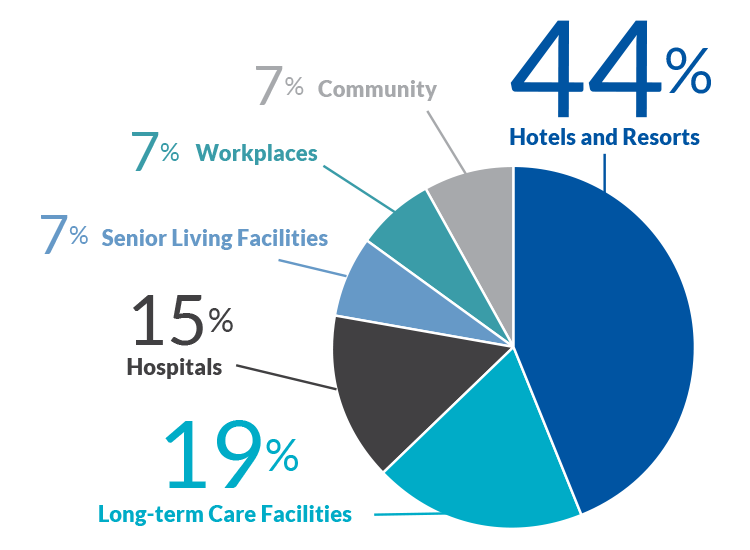What Types of Facilities Have Legionnaires’ Disease Outbreaks?
Where are cases of Legionnaires’ disease most commonly found? A small study published in the CDC’s Morbidity and Mortality Weekly Report found that Legionnaires’ Disease outbreaks occurred in a surprisingly broad variety of facilities.
The most frequent Legionnaires’ disease outbreak settings were hotels and resorts (44%), long-term care facilities (19%), and hospitals (15%). The other Legionnaires’ disease outbreaks were evenly distributed among senior living facilities (7%), workplaces (7%), and the community (7%).

How were the Legionella bacteria transmitted to the individual? Potable water was the most frequent source of exposure (56%), followed by cooling towers (22%), hot tubs (7%), industrial equipment (4%), and decorative fountains (4%).
58% of the outbreaks in hotels and resorts (often referred to as “travel-associated outbreaks”) and 67% of outbreaks in hospitals and long-term care facilities (“healthcare-associated outbreaks”) were associated with potable water, which is drinking and washing water as well as water suitable for food use.
According to the CDC, the most common form of transmission of Legionella is the inhalation of contaminated aerosols. There is no direct human-to-human transmission. Showerheads are only one possible source of potable water exposure. Spending time near sink faucets and aspiration of drinking water or ice chips are possible routes of transmission, particularly among immunocompromised individuals. These types of transmission areas often benefit from point of use (POU) filters to remove Legionella and other pathogens such as Mycobacteria and Pseudomonas, as well as system-wide treatment using copper-silver ionization, or other disinfectants, point of entry (POE) filters, and other approaches.
Sources of aerosols that have been linked with the transmission of Legionella include cooling towers, hot and cold water systems, humidifiers, and whirlpool spas. However, an infection can also occur by aspiration of contaminated water or ice, particularly in susceptible hospital patients, and by exposure of babies during water births.
If you work in any of the types of facilities mentioned above, it is important that you have an up-to-date water management program that includes Legionella testing, Legionella mitigation, and plans for Legionella remediation in case of a Legionnaires’ disease outbreak. Moreover, if you work in a healthcare-related facility such as a hospital, nursing home, long-term care facility, or skilled nursing facility, your organization may also be subject to strict regulation and ongoing requirements to stay open.
If you don’t have an active water management program or it has not been updated recently, it is important that you contact Legionella Control Systems right away for advice on your next steps. As a truly independent Legionella control company, Legionella Control Systems can help you find the best, most cost-effective Legionella solution.
We can also help you with your Legionella risk assessment, Legionella testing, Legionella remediation, and everything else you need to control Legionella. Contact a Legionella Control Systems expert now.







